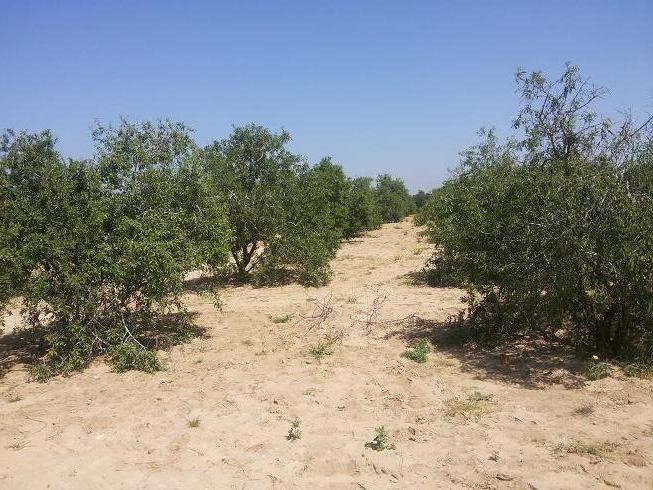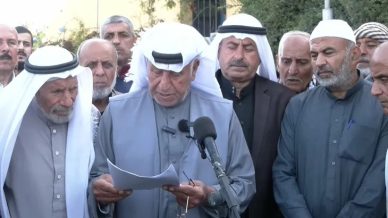The Almond tree is now barely breathing south of the Gaza Strip due to the bullets fired by Israeli occupation forces (IOF) from adjacent military barracks. Paradoxically enough the tree’s last breath is taken away as its flowers are unable to blossom because of IOF uninterrupted shootings.
An unusual silence engulfs the area and a wind carrying bad omens hangs over the place foretelling an awaited tragedy that is due to contaminate the military-controlled border fence.
The Almond tree is forced out of the border’s military sites due to the brutal uprootedness-processes so frequently executed by IOF on several lands during Al-Intifada. Other geo-economic factors were also decisive in dislodging the Almond tree from its native soils.
Persistent as the tree has always literally and symbolically been it has never ceased to find a new home where it can set up its roots in other regions of Khan Younis south of Gaza Strip seeking out fertile soil and fresh water in its eternal quest for survival.
The overall area of green almonds has reached 735 dunums with a yearly production that has gone up to 642 tons.
Old Products
During lunch-break farmer Abdullah Suleiman 58 said while sipping his Arabic coffee in a modest room crammed with agricultural equipment: “Abu Ajin has been historically famous for planting local Almond trees. The tree’s prominence stems from its quasi self-reliant nature occasionally nourished by rainwater. The Almond tree’s willingness to survive for decades is just amazing.”
Suleiman added as he wiped his sweating forehead: “The growing of almonds has declined due to several reasons most notably the occupation’s conscious and subconscious attempts to obliterate its existence particularly near the borders as if by doing so they seemed to concretize part of their de-historicization plans. The tree was the sole source of life to dozens of farmers. I myself had more than 40 dunums uprooted in 2004 by Israeli bulldozers which deracinated other fruitful almond trees in two other neighboring orchards. For native inhabitants the tree has not only been the sole source of life but for many of us it represented life itself.
A Story of My Own
A friend gave me a lift via a motorcycle to Abu Glebiya orchard where silence occasionally interspersed with bird whistles overwhelmed the area. Hadj Abou Jribane whom we found lying on the grass under an almond tree drinking a cup of tea voiced his sorrow as follows:
“We’ve been nurturing Almond trees for years now. It has never been a source of exhaustion to local farmers.” The old man added while cracking some dry almonds with a wooden stick as if he were letting out a suppressed anger: “These were the only local almonds in occupied Palestine until new American almonds bigger in size but weaker in productivity rates appeared in the aftermath of 67 years of occupation.”
The tree has been the farmer’s 40-year companion denoting an eternal love story that has been enthralling the man for years.
The Almond tree falls apart
As I headed toward the east I met Haj Suleiman Samiri 70 nicknamed the “home” for his astounding ability to tell of the city’s tales in minute details.
Haj Smiri who has just woken up from an afternoon nap told us as he did many before us that the Almond tree has been planted in the village for decades when it wasn’t possible for Israeli occupation to reach our orchards. But now things have changed and Almond trees have either disappeared or in the best of cases replaced by other plants. Everybody knows what harm IOF has done to us.
Huge amounts of almonds used to be cultivated for local and external use. I myself had grown15 dunums of almond trees but in the aftermath of the Israeli occupation only one has remained! Today we can barely come across a single new Almond tree grown in the area.
PIC news reporter quoted Fathi Abu Shamala head of Almonds Horticulture Department at the Ministry of Agriculture as stating that such rainwater-dependent-trees are now threatened with extinction given the insufficient rainwater and lethal diseases contaminating the area along with the frequent brutal uprootedness procedures recurrently executed by the Israeli occupation forces.
Today most of the stories told by Almond tree farmers about the existential and historical value of the tree are characterized by mixed feelings of pride and regret with the former designating the tree’s eternal quest for survival and the latter foreshadowing the tragedy of a tree that is due to perish as a result of the Israeli occupation’s practices.















